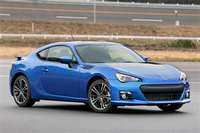Subaru's New EyeSight System Debuts at New York International Auto Show
 |
- Stereo camera-based Driver Assist System
- Pre-Collision Braking
- System capable of pedestrian detection
- Lane departure and sway warning
- Adaptive cruise control
MISSISSAUGA, ON--April 5, 2012: Subaru Canada, Inc. (SCI) will introduce its brand new EyeSight driver assistance system on its 2013 Legacy and Outback 3.6R Limited Package models later this year. This suite of safety and driver assist technologies will debut at the New York International Auto Show and will subsequently appear on other products in the Subaru lineup in future years. This new technology, which can detect obstacles in front of the car and limit potential damage in an impact, reinforces Subaru's commitment to remaining leaders in safety. EyeSight also integrates adaptive cruise control, pre-collision braking and a vehicle lane departure warning. Combining safety and convenience features, the Subaru EyeSight system will be one of the most affordable such technologies available in the North American market. Unlike other manufacturers who only introduce this system in top-end models, Subaru's plans to incorporate EyeSight in its intermediate, mid-size segment will further enhance an already value-packed offering.
EyeSight uses two charge-coupled device (CCD) cameras developed by Subaru. EyeSight is mounted inside the car on the upper edge of the windshield, thus reducing the potential for damage that could occur in bumper-mounted systems, such as radar. The EyeSight system processes stereo images to identify the vehicles travelling in front, as well as obstacles, traffic lanes and other items. The video information is relayed to the EyeSight computer, which is also networked with the car's braking system and electronic throttle control. Below speeds of approximately 30 km/h, EyeSight is capable of detecting pedestrians in the vehicle's path and can activate in order to mitigate or even avoid the collision. Under certain circumstances, EyeSight is able to bring the car to a complete stop, thus avoiding a collision.
Pre-Collision Braking Control and
Collision Mitigation
At relative speeds under approximately 30 km/h, EyeSight's Pre-Collision
Braking System can help avoid a potential collision. The system can
detect obstacles in the car's path and, if the driver has not applied
the brakes in time, the system can act to slow the vehicle or bring it
to a full stop. Pre-Collision Braking is always on in the background to
act like a second set of eyes for the driver. It can also be turned
off temporarily for off-road or rough road travel.
At relative speeds above approximately 30 km/h, EyeSight will mitigate potential damage from a collision. The system can apply the brakes when an object is detected, and will attempt to brake if the driver takes no evasive action or does not brake appropriately. The system, which can recognize programmed objects such as vehicles, motorcyclists, bicyclists and pedestrians, can help mitigate collision damage.
Lane Departure and Sway
Warning
By monitoring traffic lane markers and lines, the Subaru EyeSight system
can detect if the car begins to wander outside the intended lane
without a turn signal being used, or if the car begins to sway within
the travel lane. Using the turn signal cancels the warning.
Adaptive Cruise C
ontrol
Intended for highway use, Eyesight's Adaptive Cruise Control system can
maintain a safe distance from the vehicle in front, braking and/or
accelerating the car as needed to maintain the driver-selected target
speed and travelling distance. Adaptive Cruise Control is operational
from 40-145 km/h and can continually brake until the vehicle stops if
the system "locks on" to a vehicle ahead.
As an added convenience, Adaptive Cruise Control assists the driver in heavy stop-and-go freeway traffic by maintaining distance from the vehicle ahead. This feature can help reduce driver fatigue, which can therefore help keep the driver alert.
Additional E
yeSight Benefits
In heavy traffic conditions, EyeSight will also alert the driver when
the vehicle ahead has moved if he or she doesn't react within several
seconds.� The technology can also help reduce collision damages by
cutting the throttle when it senses an obstacle in front, but the
accelerator pedal continues to be pushed. The system is also effective
when a driver shifts into Drive inadvertently instead of Reverse when
backing out of a parking space, providing the system has been turned on
for at least 10 seconds. EyeSight's stereo camera design provides a
detection angle wider than that of radar-based systems.
Cauti
ons
EyeSight is not designed as a substitute for due care and attention to
the road. The system may not react in every situation. There are
certain operational limitations, such as when weather conditions
obscure the view of the cameras. Finally, even with the advanced
technology used, a driver with good vision and who is paying attention
will always be the best safety system.


